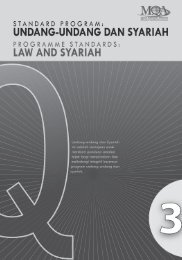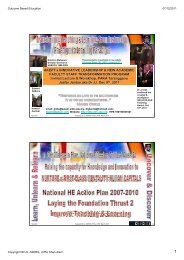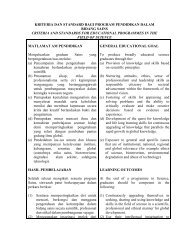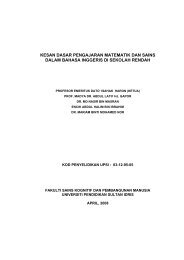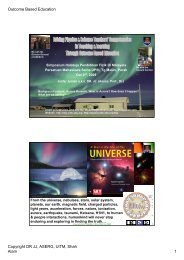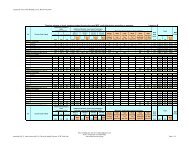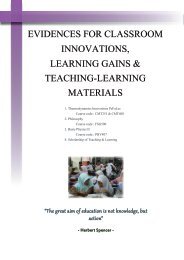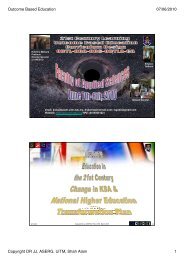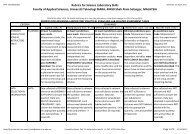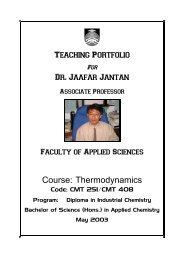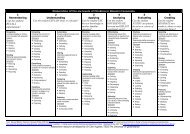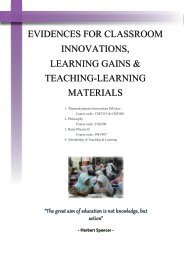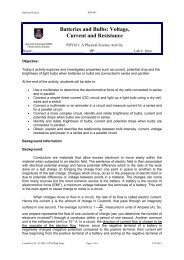Power point presentation (pdf grayscale) - Dr. Jaafar Jantan - UiTM
Power point presentation (pdf grayscale) - Dr. Jaafar Jantan - UiTM
Power point presentation (pdf grayscale) - Dr. Jaafar Jantan - UiTM
You also want an ePaper? Increase the reach of your titles
YUMPU automatically turns print PDFs into web optimized ePapers that Google loves.
Classroom Action Reasearch 2/7/2010<br />
COPPA<br />
Me & E. De Bono<br />
Perak Matriculation College<br />
Gopeng, Feb 5 th -6 th 2010<br />
<strong>Jaafar</strong> <strong>Jantan</strong> a.k.a. DR. JJ (Assoc. Prof. <strong>Dr</strong>.)<br />
“The principle goal of education is to create men who are capable of<br />
doing new things, not simply of repeating what other generations have<br />
done -- men who are creative, inventive and discoverers. “ Jean Piaget<br />
“The only person who is educated is the one who has learned how<br />
to learn and change.” Carl Rogers<br />
email: jjnita@salam.uitm.edu.my, drjjlanita@hotmail.com;<br />
Website: http://drjj.uitm.edu.my; HP: +60193551621<br />
Me & H. Gardner<br />
Copyright DR JJ, ASERG, <strong>UiTM</strong>, Shah Alam; Feb 2010 1<br />
Me with the Director General of UNESCO<br />
Born & Raised in the state of Hang Jebat…<br />
Early education at St. David’s, Science Malacca (‘77-’78) & SDAR (Seremban) (’79)<br />
B.Sc. Physics (1983); M.Sc. Condensed Matter (1985) - KSU<br />
Teaching Certificate (1986) – MPTI, JB<br />
Served ITM – Jan 1987<br />
PhD Physics Education (1991-1994)<br />
Physics & Education expert<br />
• Practiced OBE & Active Learning on his own since 1997.<br />
• Vice-Chair Asian Physics Education Network (ASPEN), UNESCO<br />
• Chair for ASPEN, Malaysia<br />
• Nominated for Innovative Teaching & Learning, National & International<br />
• Member, Science Educ. Committee, Academy Science Malaysia since 2005.<br />
• Keynote, Plenary and Invited Speaker in Conferences Nationally &<br />
Internationally<br />
• Liason officer Between <strong>UiTM</strong> & JPT on LOKI-based curriculum review<br />
Copyright DR JJ, ASERG, <strong>UiTM</strong>, Shah Alam; Feb 2010 2<br />
http://drjj.uitm.edu.my<br />
Developing 3 Domains of Education<br />
Cognitive<br />
Head<br />
Knowing, the Head<br />
The KNOWLEDGE<br />
Intellectual Skills<br />
Psychomotor<br />
Doing, The Hand, Body<br />
The SKILLS<br />
3H<br />
Affective<br />
Heart<br />
Feeling, The Heart<br />
The CARE, Emotions<br />
Copyright DR JJ, ASERG, <strong>UiTM</strong>, Shah Alam; Feb 2010 3<br />
Copyright DR JJ, ASERG, <strong>UiTM</strong>, Shah Alam 1
Classroom Action Reasearch 2/7/2010<br />
http://drjj.uitm.edu.my<br />
http://drjj.uitm.edu.my<br />
Can explain: provide thorough, supported, and justifiable accounts<br />
of phenomena, facts, and data.<br />
Can interpret: tell meaningful stories; offer apt translations; provide<br />
a revealing historical or personal dimension to ideas and events;<br />
make it personal or accessible through images, anecdotes,<br />
analogies, and models.<br />
Can apply: effectively use and adapt what we know in diverse<br />
contexts.<br />
Have perspective: see and hear <strong>point</strong>s of view through critical eyes<br />
and ears; see the big picture.<br />
Can empathize: find value in what others might find odd, alien, or<br />
implausible; perceive sensitively on the basis of prior direct<br />
experience.<br />
Have self-knowledge<br />
knowledge: perceive the personal style, prejudices,<br />
projections, and habits of mind that both shape and impede our own<br />
understanding; we are aware of what we do not understand and why<br />
understanding is so hard<br />
Source: Grant Wiggins and Jay McTighe. Understanding by Design; Chap 4.<br />
Source: Grant Wiggins and Jay McTighe. Understanding by Design; Chap 4.<br />
Copyright DR JJ, ASERG, <strong>UiTM</strong>, Shah Alam; Feb 2010 5<br />
Copyright DR JJ, ASERG, <strong>UiTM</strong>, Shah Alam; Feb 2010 6<br />
Research is the systematic process of collecting and<br />
analyzing information to increase our understanding of the<br />
phenomenon under study.<br />
Research is all about addressing an issue or asking and<br />
answering a question or solving a problem, Research<br />
characteristics are:<br />
Systematic, logical, empirical, reductive, replicable<br />
Copyright DR JJ, ASERG, <strong>UiTM</strong>, Shah Alam; Feb 2010 7 Copyright DR JJ, ASERG, <strong>UiTM</strong>, Shah Alam; Feb 2010 8<br />
Copyright DR JJ, ASERG, <strong>UiTM</strong>, Shah Alam 2
Classroom Action Reasearch 2/7/2010<br />
Learning Outcomes<br />
At the end of this session, participants will be able to:<br />
1. Describe what is action research.<br />
2. Explain, with examples, the operational definition of Reflection<br />
3. Recite, repeat and discuss the cycle involved in doing action<br />
research.<br />
4. Describe, with examples, how to conduct an action research.<br />
5. Write a log of the events unfolding in every module during the<br />
workshop/lecture.<br />
6. Reflect and suggest a topic to study.<br />
7. Suggest the plan of action.<br />
8. Propose the tools of data collection and analysis.<br />
“We must produce confident students with a sense of balance<br />
and proportion. . While an individual may specialise in a certain<br />
area, his or her perspective should be enriched by other<br />
experiences as well.”<br />
Source: NATIONAL HIGHER EDUCATION ACTION PLAN 2007-2010<br />
Suggested reading on action research:<br />
"Taking Action with Teacher Research" edited by Ellen Meyers and Frances Rust<br />
Copyright DR JJ, ASERG, <strong>UiTM</strong>, Shah Alam; Feb 2010 9<br />
Copyright DR JJ, ASERG, <strong>UiTM</strong>, Shah Alam; Feb 2010 10<br />
ACTIVITY….<br />
The difficult thing about doing action research is that you have to override most of what you've<br />
learned about research as an activity. In a traditional research culture you begin by framing a<br />
question, setting up a situation which might provide some information, collecting data which<br />
bears on the question, then writing up results.<br />
Action research isn't like that at all. The research activity begins in the middle of whatever<br />
it is you're doing — something happens that you didn't expect<br />
The dilemma in an action research situation is you may not even realize something<br />
interesting has occurred that you ought to think about unless you're already in the<br />
habit of keeping a journal or reflective log. Because teaching, like other activities which<br />
occur in and around schools, is so complex, we're accustomed to coping with the<br />
many things demanding our attention at once without really thinking ing about them; we<br />
generally don't make a <strong>point</strong> of recording those moments which surprise or perplex us<br />
or stand out for some other reason during the course of the day. So, unless we create<br />
for ourselves regular reflective accounts of what's going on, we're not likely to get anywhere.<br />
Copyright DR JJ, ASERG, <strong>UiTM</strong>, Shah Alam; Feb 2010 11<br />
Copyright DR JJ, ASERG, <strong>UiTM</strong>, Shah Alam; Feb 2010 12<br />
Copyright DR JJ, ASERG, <strong>UiTM</strong>, Shah Alam 3
Classroom Action Reasearch 2/7/2010<br />
As Leaphorn advises Chee in Hillerman's novel, Sacred Clown, "I want you to tell me everything<br />
— don't leave out stuff you think is trivial." In fact, you won't know what is trivial until patterns<br />
begin to emerge, and even then what seems trivial, may turn out to be significant later — you<br />
just can't tell.<br />
The hardest part of beginning an action research project is developing the discipline to<br />
keep a written account, of recording on a regular basis the details of what's happening,<br />
particularly when you have no idea what you're looking for. For unlike traditional research,<br />
action research begins not with a research question but with the muddle of daily work, with the<br />
moments that stand out from the general flow, and unless we record those moments they<br />
vanish, unavailable as data for reflection, for discerning some larger pattern of experience. So<br />
it's necessary to keep fairly detailed notes. Whether it's a journal, a daily log, critical incidents<br />
(Newman, 1987, 1991) jotted on index cards, or more extensive field notes, without a written<br />
account, the enterprise cannot proceed.<br />
Source: ACTION RESEARCH:EXPLORING THE TENSIONS OF TEACHING. Judith M. Newman, Ph.D. In: Newman, Judith M. 1998<br />
Tensions of Teaching: Beyond Tips to Critical Reflection. Toronto/New York: Canadian Scholars' Press/Teachers College Press: 1-24.<br />
“…teacher<br />
teacher-initiated classroom investigation<br />
seeking to increase<br />
the teachers’ understanding<br />
of classroom teaching and learning,<br />
and to bring about change<br />
in classroom practices.”<br />
Source: Teachers’ Network (Ministry of Education, Singapore) publication on Learning Circles<br />
Copyright DR JJ, ASERG, <strong>UiTM</strong>, Shah Alam; Feb 2010 13<br />
Copyright DR JJ, ASERG, <strong>UiTM</strong>, Shah Alam; Feb 2010 14<br />
Inquiry-based research<br />
conducted by teachers<br />
that follows a process of examining existing practices,<br />
implementing new practices,<br />
and evaluating the results,<br />
leading to an improvement cycle<br />
that benefits both students and teachers.<br />
Also known as: practitioner research, teacher research, site-based<br />
research, and action science.<br />
cs3.wnmu.edu/elearning/a404/support/a404b0_50100.html<br />
“Professionals studying their own practice in order to improve<br />
it.<br />
Applied to teaching, it involves gathering and interpreting<br />
"data" to better understand an aspect of your teaching that<br />
interests or concerns you.<br />
An alternative to teachers who have been encouraged to look to<br />
others, rather than to themselves and their students, for ways<br />
to improve their teaching.<br />
Action research is an important recent development in the<br />
broad territory of "teachers' professional development."<br />
Source: Tom Russell, Queen’s University; http://educ.queensu.ca/~russellt/howteach/arguide.htm#arwhy<br />
Copyright DR JJ, ASERG, <strong>UiTM</strong>, Shah Alam; Feb 2010 15<br />
Copyright DR JJ, ASERG, <strong>UiTM</strong>, Shah Alam; Feb 2010 16<br />
Copyright DR JJ, ASERG, <strong>UiTM</strong>, Shah Alam 4
Classroom Action Reasearch 2/7/2010<br />
Kurt Lewin (1940)<br />
Stephen Corey (1950)<br />
Lawrence Stenhouse (1970s)<br />
Carr and Kemmis (1980s to date)<br />
John Elliot (1990s to date)<br />
Donald Schon (1980s)<br />
Jack Whitehead (1970 to date)<br />
Jean McNiff (1990 to date)<br />
A particular way of researching your own learning;<br />
A practical way of looking at your practice in order to check<br />
whether it is as you feel it should be…;<br />
If you feel that your practice needs attention in some way you<br />
will be able to take action to improve it, and then produce<br />
evidence to show in what way the practice has improved.<br />
Source: Jean McNiff, 2002; Action Research Principles and Practice<br />
Action research is solving problems through the application of the t<br />
scientific method.<br />
Copyright DR JJ, ASERG, <strong>UiTM</strong>, Shah Alam; Feb 2010 17<br />
Copyright DR JJ, ASERG, <strong>UiTM</strong>, Shah Alam; Feb 2010 18<br />
OBSERVE<br />
4. Observe, monitor<br />
and record<br />
1. Think about what<br />
we want to focus on<br />
REFLECT<br />
5. Reflect on what has happened<br />
to improve further<br />
ACT<br />
3. Carry out plan, collect evidence<br />
PLAN<br />
2. Plan what to do<br />
Latin “reflectere” : To bend back<br />
INVOLVES “SHUTTLING BACK AND FORTH BETWEEN THINKING AND<br />
ACTION”<br />
•Looking back on experience to improve practice<br />
•Learning in the midst of practice<br />
•Making decisions about what to do<br />
Copyright DR JJ, ASERG, <strong>UiTM</strong>, Shah Alam; Feb 2010 19<br />
Copyright DR JJ, ASERG, <strong>UiTM</strong>, Shah Alam; Feb 2010 20<br />
Copyright DR JJ, ASERG, <strong>UiTM</strong>, Shah Alam 5
Classroom Action Reasearch 2/7/2010<br />
We review our current practice,<br />
identify an aspect that we want to investigate,<br />
imagine a way forward,<br />
try it out, and<br />
take stock of what happens.<br />
We modify what we are doing in the light of what we<br />
have found, and continue working in this new way (try<br />
another option if the new way of working is not right)<br />
monitor what we do,<br />
review and evaluate the modified action,<br />
and so on …<br />
Source: Action research for professional development, Concise advice for new action<br />
researchers. Third edition © Jean McNiff 2002<br />
Copyright DR JJ, ASERG, <strong>UiTM</strong>, Shah Alam; Feb 2010 21<br />
N atu re o f R e fle ctio n<br />
R eturning to experience<br />
• R ecalling or detailing salient events<br />
A ttending to (or co nnecting w ith) feelings<br />
• U sing helpful feelings<br />
• R em o ving or containing obstructive ones<br />
Evaluating experience<br />
• R e-exam ining experience in the light of one’s<br />
aim s and know ledge<br />
• Entails integrating this new know ledge into one’s<br />
conceptual fram ew ork<br />
Source: http://www.infed.org/biblio/b-reflect.htm<br />
Copyright DR JJ, ASERG, <strong>UiTM</strong>, Shah Alam; Feb 2010 22<br />
Level 1<br />
Involves technical application of knowledge and skills in the<br />
classroom setting.<br />
Level 2<br />
Emphasizes examination of assumptions underlying practice.<br />
Level 3<br />
Emphasizes moral and ethical issues of practicality to values and<br />
beliefs.<br />
Source: Quality Teaching: Reflection, the heart of Practice by Joelle K. Jay. 2003<br />
Stop to reflect<br />
Rushing around makes Life becomes a blur<br />
Reflection helps us to focus…<br />
Reflection is the bridge between thinking<br />
and acting<br />
Helps us To think<br />
and act<br />
and think again…<br />
Copyright DR JJ, ASERG, <strong>UiTM</strong>, Shah Alam; Feb 2010 23<br />
Copyright DR JJ, ASERG, <strong>UiTM</strong>, Shah Alam; Feb 2010 24<br />
Copyright DR JJ, ASERG, <strong>UiTM</strong>, Shah Alam 6
Classroom Action Reasearch 2/7/2010<br />
A reflective thinker is aware of her own knowledge (skills and<br />
empathy) and lack of knowledge (skills and empathy) and<br />
recognizes that there may not be only a single correct solution to<br />
a problem or interpretation of a situation. A reflective thinker<br />
relies on all available resources to find relevant needed<br />
information and opinions in order to come to a personal<br />
understanding of a situation, knowing that this understanding<br />
may change, as she gains more information and insight into the<br />
matter.<br />
http://ldt.stanford.edu/ldt1999/Students/cmazow/MajorProject/refThinkLoMain.htm<br />
Teaching effectiveness – better understanding, grades, attitude<br />
towards learning, teaching materials and acquisition of the key<br />
competencies<br />
Classroom management & discipline– better student behaviour<br />
(punctuality, reduced disruptions in class, better attention span)<br />
Use of information technology- effective use of IT to “deliver” the<br />
content)<br />
Curriculum innovation- interdisciplinary efforts using Pmodel or<br />
similar frameworks eg. PBL<br />
Assessment methodologies - use of alternative assessment tools –<br />
student portfolios, checklists, peer assessment, student<br />
reflections<br />
Development of students through attributes - leadership skills,<br />
self-esteem, personal development.<br />
Copyright DR JJ, ASERG, <strong>UiTM</strong>, Shah Alam; Feb 2010 25<br />
Copyright DR JJ, ASERG, <strong>UiTM</strong>, Shah Alam; Feb 2010 26<br />
►1. What is the problem or question you want answered<br />
►2. Define the problem/question in clear, specific language. The<br />
question may be general or specific.<br />
“Does the new Math Lab increase math grades or math test<br />
scores”<br />
Will the use of Concept Maps improve students’ conceptual<br />
understanding<br />
Can the use of simulations improve students’ knowledge of<br />
electrostatics<br />
2. Define the problem/question (con.).<br />
“Will students’ learning preferences affect their science reasoning<br />
skills”<br />
“Will repeating lesson outcomes throughout a lesson increase<br />
students’ retention”<br />
“Can cooperative group discussion during lectures improve<br />
students’ ability to achieve the learning outcome”<br />
Will a 2-minute 2<br />
end-of<br />
of-class reflection reveal students’ achievement<br />
of the learning outcomes”<br />
Carey Dimmitt, John Carey and Carole Schweid; ; School Counseling Leadership Institute, 2003<br />
Copyright DR JJ, ASERG, <strong>UiTM</strong>, Shah Alam; Feb 2010 27<br />
Carey Dimmitt, John Carey and Carole Schweid; ; School Counseling Leadership Institute, 2003<br />
Copyright DR JJ, ASERG, <strong>UiTM</strong>, Shah Alam; Feb 2010 28<br />
Copyright DR JJ, ASERG, <strong>UiTM</strong>, Shah Alam 7
Classroom Action Reasearch 2/7/2010<br />
►3. What have others found Search for resources and review the<br />
relevant research literature.<br />
Has anyone in the school asked this question before<br />
Who might have information<br />
What is the relevant research in professional journals<br />
What does an internet search find on this topic<br />
►4. What is the purpose of the study or research<br />
Why do you want to know this<br />
What educational practices should have been impacted by your<br />
intervention<br />
What student outcomes are you hoping to influence<br />
Will the study help you make decisions About what<br />
Carey Dimmitt, John Carey and Carole Schweid; ; School Counseling Leadership Institute, 2003<br />
Copyright DR JJ, ASERG, <strong>UiTM</strong>, Shah Alam; Feb 2010 29<br />
Carey Dimmitt, John Carey and Carole Schweid; ; School Counseling Leadership Institute, 2003<br />
Copyright DR JJ, ASERG, <strong>UiTM</strong>, Shah Alam; Feb 2010 30<br />
►5. Do you have a hypothesis/hypotheses about what you will find<br />
What is your hypothesis Or, what do you think the answer(s) ) will be<br />
This helps you identify your biases, which may impact your process.<br />
What is the opposite of your hypothesis (the “null hypothesis”)<br />
What would the data look like if you were wrong<br />
►6. Select or prepare the data and/or instrument(s) ) you will use to<br />
answer your question(s). There are many kinds of data to use.<br />
Instruments include surveys, tests, questionnaires, interview questions, q<br />
etc.<br />
►Is you instrument valid Is it reliable<br />
►7. Select an appropriate sample of an appropriate size.<br />
Carey Dimmitt, John Carey and Carole Schweid; ; School Counseling Leadership Institute, 2003<br />
Copyright DR JJ, ASERG, <strong>UiTM</strong>, Shah Alam; Feb 2010 31<br />
Carey Dimmitt, John Carey and Carole Schweid; ; School Counseling Leadership Institute, 2003<br />
Copyright DR JJ, ASERG, <strong>UiTM</strong>, Shah Alam; Feb 2010 32<br />
Copyright DR JJ, ASERG, <strong>UiTM</strong>, Shah Alam 8
Classroom Action Reasearch 2/7/2010<br />
►8. Select a research design (descriptive quasi/-experimental)<br />
Looking at how one group changes over time<br />
►Use descriptive statistics (median, mode, frequencies,<br />
percentages)<br />
►Use t-tests t tests or Chi-Square<br />
Looking at differences between control and intervention groups<br />
►Use t-test t test or Chi-Square<br />
Looking at differences among more than 2 groups<br />
►Use Analysis of Variance (ANOVA)<br />
►9. Collect the research data<br />
most schools already have several sources of data available, ready<br />
for analysis<br />
use multiple outcome measures wherever possible<br />
obtain permission, if necessary<br />
follow ethical guidelines<br />
ensure an adequate, appropriate sample<br />
Carey Dimmitt, John Carey and Carole Schweid; ; School Counseling Leadership Institute, 2003<br />
Copyright DR JJ, ASERG, <strong>UiTM</strong>, Shah Alam; Feb 2010 33<br />
Carey Dimmitt, John Carey and Carole Schweid; ; School Counseling Leadership Institute, 2003<br />
Copyright DR JJ, ASERG, <strong>UiTM</strong>, Shah Alam; Feb 2010 34<br />
►10. Edit, organize and code the data for analysis<br />
►11. Analyze and interpret the data<br />
use statistics to analyze<br />
use graphs, tables and pictures to represent findings<br />
►12. Report conclusions<br />
Decide on audience(s)<br />
Make recommendations and decisions based on conclusions<br />
Structure report/<strong>presentation</strong> so that the most relevant information<br />
ion<br />
is presented to audience<br />
Don’t t exclude important information<br />
Don’t t present only results that support your hypotheses<br />
Relate findings to purposes of study, hypotheses and previous<br />
research<br />
Carey Dimmitt, John Carey and Carole Schweid; ; School Counseling Leadership Institute, 2003<br />
Copyright DR JJ, ASERG, <strong>UiTM</strong>, Shah Alam; Feb 2010 35<br />
Carey Dimmitt, John Carey and Carole Schweid; ; School Counseling Leadership Institute, 2003<br />
Copyright DR JJ, ASERG, <strong>UiTM</strong>, Shah Alam; Feb 2010 36<br />
Copyright DR JJ, ASERG, <strong>UiTM</strong>, Shah Alam 9
Classroom Action Reasearch 2/7/2010<br />
►13. Evaluate Research<br />
What would you do differently next time<br />
Revision of instrument if re-using<br />
Did research generate information you wanted<br />
What questions did the research generate<br />
►What are your biases/Mental Models How are they impacting the<br />
questions you’re asking and the places you’re looking<br />
►Evaluating findings from research literature and internet searches<br />
es<br />
What is the source How reliable is it<br />
What are the strengths/weaknesses of the research design,<br />
sampling, effect size, measures used, treatment fidelity, researcher<br />
bias, instrument reliability and validity<br />
Carey Dimmitt, John Carey and Carole Schweid; ; School Counseling Leadership Institute, 2003<br />
Copyright DR JJ, ASERG, <strong>UiTM</strong>, Shah Alam; Feb 2010 37<br />
Carey Dimmitt, John Carey and Carole Schweid; ; School Counseling Leadership Institute, 2003<br />
Copyright DR JJ, ASERG, <strong>UiTM</strong>, Shah Alam; Feb 2010 38<br />
►Data:<br />
How accurate is the data you’ve chosen to use<br />
What’s s missing<br />
►Instruments:<br />
Reliability and validity<br />
Just because it exists doesn’t t mean it’s s well done<br />
►Sampling and Research Design:<br />
Size of sample<br />
Comparability of sample and control<br />
Matching vs. random assignment<br />
Assuring fidelity of treatment<br />
►Doing same thing across different groups<br />
Carey Dimmitt, John Carey and Carole Schweid; ; School Counseling Leadership Institute, 2003<br />
Copyright DR JJ, ASERG, <strong>UiTM</strong>, Shah Alam; Feb 2010 39<br />
Carey Dimmitt, John Carey and Carole Schweid; ; School Counseling Leadership Institute, 2003<br />
Copyright DR JJ, ASERG, <strong>UiTM</strong>, Shah Alam; Feb 2010 40<br />
Copyright DR JJ, ASERG, <strong>UiTM</strong>, Shah Alam 10
Classroom Action Reasearch 2/7/2010<br />
►Ethical Considerations:<br />
Consent<br />
Human Subjects Review<br />
Denying access to interventions- remediation<br />
►Data Analysis<br />
Use expert consultation or university collaboration to get needed<br />
information<br />
►Results Presentation<br />
All the data that’s s relevant must be presented, even if it contradicts<br />
expectations or ruffles feathers<br />
Who has access to data results<br />
Extrapolation and generalization of findings<br />
Carey Dimmitt, John Carey and Carole Schweid; ; School Counseling Leadership Institute, 2003<br />
Copyright DR JJ, ASERG, <strong>UiTM</strong>, Shah Alam; Feb 2010 41<br />
Carey Dimmitt, John Carey and Carole Schweid; ; School Counseling Leadership Institute, 2003<br />
Copyright DR JJ, ASERG, <strong>UiTM</strong>, Shah Alam; Feb 2010 42<br />
►Results Presentation<br />
All the data that’s s relevant must be presented, even if it contradicts<br />
expectations or ruffles feathers<br />
Who has access to data results<br />
Extrapolation and generalization of findings<br />
Carey Dimmitt, John Carey and Carole Schweid; ; School Counseling Leadership Institute, 2003<br />
Copyright DR JJ, ASERG, <strong>UiTM</strong>, Shah Alam; Feb 2010 43<br />
► What is the purpose of your work (action research proposal<br />
introduction)<br />
► Why is this work important for the science (introduction)<br />
► Are there any similarities with the other researches on this<br />
theme (action research proposal literature review)<br />
► Will this background information be enough for this investigation<br />
n<br />
( literature review)<br />
► What way is it better to choose in order to write this work<br />
(action research proposal main body)<br />
► What will be described in this paper first (main body)<br />
► What results are achieved (action research proposal conclusion)<br />
Carey Dimmitt, John Carey and Carole Schweid; ; School Counseling Leadership Institute, 2003<br />
Copyright DR JJ, ASERG, <strong>UiTM</strong>, Shah Alam; Feb 2010 44<br />
Copyright DR JJ, ASERG, <strong>UiTM</strong>, Shah Alam 11
Classroom Action Reasearch 2/7/2010<br />
Use Habermas’s (1976) four criteria for judging communicative<br />
validity.<br />
Understandable - that is, the writer must find a way of<br />
communicating their ideas so that the writer and the reader can<br />
understand each other.<br />
Sincere - so the writer needs to communicate the story in a way<br />
that the reader can share the knowledge of the writer.<br />
Truthful - so that the reader can believe the writer.<br />
communicated appropriately - that is, it must be written in a way<br />
that takes into account the socio-cultural cultural circumstances of the<br />
present situation, so that both writer and reader can see that the t<br />
report makes sense within an existing context.<br />
Source: AERA professional Development Training and Extended Courses Proposal<br />
osal<br />
http://www.jeanmcniff.com/aera08/jmjwAERA_prof_dev_2008_final.htm<br />
Copyright DR JJ, ASERG, <strong>UiTM</strong>, Shah Alam; Feb 2010 45<br />
They are written for a reader. The author takes the responsibility for not<br />
assuming that the reader already knows what the author is thinking. ng. The<br />
author leads the reader carefully through the account.<br />
They are explanatory research reports, that is, they give the reasons for<br />
undertaking the research, as well as the goals for the research. They do not<br />
offer only descriptions, although descriptions of actions and learning are a key<br />
part of the report.<br />
Because they are research reports, they articulate a claim to knowledge. This<br />
means first identifying and articulating a research question, showing how data<br />
was gathered and how evidence was generated by searching the data a for<br />
instances that show how the research question is addressed. Evidence is then<br />
extracted from the data, and is used as the grounds against which h to test the<br />
validity of the claim to knowledge.<br />
Source: AERA professional Development Training and Extended Courses Proposal<br />
osal<br />
http://www.jeanmcniff.com/aera08/jmjwAERA_prof_dev_2008_final.htm<br />
Copyright DR JJ, ASERG, <strong>UiTM</strong>, Shah Alam; Feb 2010 46<br />
They explain the processes of the research, in relation to the criteria c<br />
for<br />
doing research: does it show methodological rigour, systematic enquiry, e<br />
the<br />
initial identification of a research issue and the generation of evidence; i.e.<br />
do they show the processes of establishing the validity of the research r<br />
claim<br />
They adopt a narrative form, in which the ‘I’ tells the research story. The<br />
story is generative and transformational: each part unfolds into the next<br />
part, and each part contains the other parts within itself.<br />
They demonstrate communicative adequacy, that is, they write for a reader.<br />
Therefore they communicate ideas in ways that are comprehensible, , honest,<br />
sincere and appropriate to the social and cultural context.<br />
They talk explicitly about the generation of knowledge, and they show the<br />
significance of the practice and the research for new forms of practice p<br />
and<br />
new forms of theory. Therefore they speak about the potential implications<br />
of the research for how research can inform practice, and practice ce can<br />
inform research. They articulate the significance of this approach for<br />
continuing professional teacher development.<br />
Source: AERA professional Development Training and Extended Courses Proposal<br />
osal<br />
http://www.jeanmcniff.com/aera08/jmjwAERA_prof_dev_2008_final.htm<br />
Source: AERA professional Development Training and Extended Courses Proposal<br />
osal<br />
http://www.jeanmcniff.com/aera08/jmjwAERA_prof_dev_2008_final.htm<br />
Copyright DR JJ, ASERG, <strong>UiTM</strong>, Shah Alam; Feb 2010 47<br />
Copyright DR JJ, ASERG, <strong>UiTM</strong>, Shah Alam; Feb 2010 48<br />
Copyright DR JJ, ASERG, <strong>UiTM</strong>, Shah Alam 12
Classroom Action Reasearch 2/7/2010<br />
1. What is my/our concern<br />
2. Why am I/are we concerned<br />
3. How do I/we gather data to show the situation as it is and as it unfolds<br />
4. What can I/we do about it (what options are available) What will l I/we do<br />
about it (what action is planned)<br />
5. How do I/we ensure that any conclusions I/we come to are reasonably fair<br />
and accurate<br />
6. How do I/we account for my~our educational influences in learning<br />
7. How do I/we modify my/our ideas and practices in the light of the<br />
evaluation<br />
Source: AERA professional Development Training and Extended Courses Proposal<br />
osal<br />
http://www.jeanmcniff.com/aera08/jmjwAERA_prof_dev_2008_final.htm<br />
Copyright DR JJ, ASERG, <strong>UiTM</strong>, Shah Alam; Feb 2010 49<br />
How worthwhile is this<br />
How valuable is it<br />
What do I value about<br />
it<br />
What is the most significant thing I<br />
have done so far<br />
What is the most significant thing I<br />
have learnt so far<br />
What is important about my learning<br />
Did the practice show an improvement How do you make<br />
judgements about any improvement in practice you may have<br />
observed<br />
Did the practice show an improvement in learning How do you make<br />
judgements about the quality of the learning<br />
How can you show how your learning has influenced someone else’s<br />
learning How do you make judgements about the quality of that<br />
influence<br />
Source: AERA professional Development Training and Extended Courses Proposal<br />
osal<br />
http://www.jeanmcniff.com/aera08/jmjwAERA_prof_dev_2008_final.htm<br />
Copyright DR JJ, ASERG, <strong>UiTM</strong>, Shah Alam; Feb 2010 50<br />
Think about this<br />
We have identified our values as what guides our practices (our standards<br />
of practice), so we can think of evaluating the quality of the practice in<br />
terms of the extent to which those values were realised. Did we realise our<br />
values of, for example, honesty, independent enquiry, efficient timekeeping,<br />
courtesy to others<br />
We have identified our values as what guides our research (our standards<br />
of judgement), so we can think of evaluating the quality of the research in<br />
terms of the extent to which those values were realised. Did we realise our<br />
values of, for example, methodological rigour, systematic enquiry,<br />
collaborative working, validating a claim to knowledge through the<br />
production of authenticated evidence<br />
Source: AERA professional Development Training and Extended Courses Proposal<br />
osal<br />
http://www.jeanmcniff.com/aera08/jmjwAERA_prof_dev_2008_final.htm<br />
Copyright DR JJ, ASERG, <strong>UiTM</strong>, Shah Alam; Feb 2010 51<br />
Think about this<br />
Can we discern that our values come to act as our living standards of<br />
practice and judgement as they emerge in our practice<br />
To what extent do the values of practice and the values of research<br />
overlap<br />
Source: AERA professional Development Training and Extended Courses Proposal<br />
osal<br />
http://www.jeanmcniff.com/aera08/jmjwAERA_prof_dev_2008_final.htm<br />
Copyright DR JJ, ASERG, <strong>UiTM</strong>, Shah Alam; Feb 2010 52<br />
Copyright DR JJ, ASERG, <strong>UiTM</strong>, Shah Alam 13
Classroom Action Reasearch 2/7/2010<br />
http://drjj.uitm.edu.my<br />
http://drjj.uitm.edu.my<br />
At the end of this activity students will be able to:<br />
4. Describe and draw the electric field patterns created by<br />
<strong>point</strong> charges surrounding a <strong>point</strong> charge.<br />
5. Describe and draw the electric field patterns surrounding<br />
two like <strong>point</strong> charges and two unlike <strong>point</strong> charges.<br />
6. Measure the strength of an electric field produced by a<br />
<strong>point</strong> charge at various localities and produce a<br />
mathematical model of the strength.<br />
At the end of this activity students will be able to:<br />
<strong>Dr</strong>aw the electric force exerted by one <strong>point</strong> charge<br />
onto another and describe the motion of charges in<br />
the presence of other <strong>point</strong> charges.<br />
Copyright DR JJ, ASERG, <strong>UiTM</strong>, Shah Alam; Feb 2010 53<br />
Copyright DR JJ, ASERG, <strong>UiTM</strong>, Shah Alam; Feb 2010 54<br />
At the end of this activity students will be able to:<br />
Describe and draw the electric field patterns<br />
created by <strong>point</strong> charges surrounding a <strong>point</strong><br />
charge.<br />
http://drjj.uitm.edu.my<br />
Using the the Electric Field Hockey PHET simulation and choose the hockey putt be<br />
the negatively charged particle feeling the force, move a negative charge near it to<br />
“see” the force exerted on the putt. Then draw the force diagram based on your<br />
observation. Using a ruler, measure the length of each force line. Now compare the<br />
force diagram for each of the electrons to your predicted diagram. How different are<br />
they Explain the similarity and differences you observed in terms of the direction and<br />
length of the force line.<br />
4<br />
3<br />
http://drjj.uitm.edu.my<br />
1<br />
2<br />
LAB<br />
Copyright DR JJ, ASERG, <strong>UiTM</strong>, Shah Alam; Feb 2010 55<br />
Copyright DR JJ, ASERG, <strong>UiTM</strong>, Shah Alam; Feb 2010 56<br />
Copyright DR JJ, ASERG, <strong>UiTM</strong>, Shah Alam 14
Classroom Action Reasearch 2/7/2010<br />
http://drjj.uitm.edu.my<br />
http://drjj.uitm.edu.my<br />
Copyright DR JJ, ASERG, <strong>UiTM</strong>, Shah Alam; Feb 2010 57<br />
Copyright DR JJ, ASERG, <strong>UiTM</strong>, Shah Alam; Feb 2010 58<br />
http://drjj.uitm.edu.my<br />
Reflection<br />
http://drjj.uitm.edu.my<br />
“The goal of intellectual education is not how to repeat or<br />
retain ready-made truths… . It is in learning to master<br />
the truth by oneself at the risk of losing a lot of time and<br />
going thru all the roundabout ways that are inherent in<br />
real activity.”<br />
(Jean Piaget, Swiss cognitive psychologist, 1896-1980)<br />
Copyright DR JJ, ASERG, <strong>UiTM</strong>, Shah Alam; Feb 2010 59<br />
Copyright DR JJ, ASERG, <strong>UiTM</strong>, Shah Alam; Feb 2010 60<br />
Copyright DR JJ, ASERG, <strong>UiTM</strong>, Shah Alam 15
Classroom Action Reasearch 2/7/2010<br />
A sample lesson from Thermodynamics<br />
Course outcome for Thermodynamics: (address PO1)<br />
Write energy balance representing the first law of thermodynamics and<br />
use it in both closed and open systems.<br />
Lesson outcomes: Upon completion of this unit, students will<br />
be able to:<br />
1. State the conservation of energy principle and name all the forms of<br />
energy entering & leaving a system and energy changes within the<br />
system.<br />
2. Discuss the energy exchange process and write mathematical<br />
expressions representing the energy balance in units of kJ, for a general<br />
system undergoing any process.<br />
3. Rewrite the energy balance in the unit-mass basis and unit-time time basis<br />
(or rate-form basis) for a general system undergoing any process.<br />
Copyright DR JJ, ASERG, <strong>UiTM</strong>, Shah Alam; Feb 2010 61<br />
Education, we see, is not merely gaining knowledge or skills helpful toward productive<br />
work, though certainly that is a part of it. Rather it is a replenishment enishment and an<br />
expansion of the natural thirst of the mind and soul. Learning is a gradual process of<br />
growth, each step building upon the other. It is a process whereby the learner<br />
organizes and integrates not only facts but attitudes and values. . The Lord has told us<br />
that we must open our minds and our hearts to learn. There is a Chinese proverb:<br />
Wisdom is as the moon rises, perceptible not in progress but in result. As our<br />
knowledge is converted to wisdom, the door to opportunity is unlocked.<br />
Barbara W. Winder<br />
The great aim of education is not knowledge, but action.<br />
Herbert Spencer<br />
The one real goal of education is to leave a person asking questions.<br />
Max Beerbohm<br />
Copyright DR JJ, ASERG, <strong>UiTM</strong>, Shah Alam; Feb 2010 62<br />
Copyright DR JJ, ASERG, <strong>UiTM</strong>, Shah Alam 16




